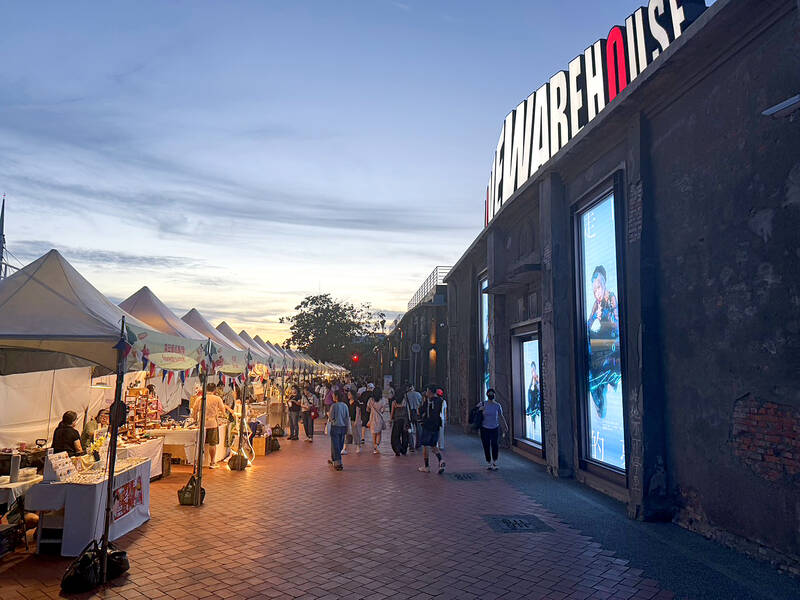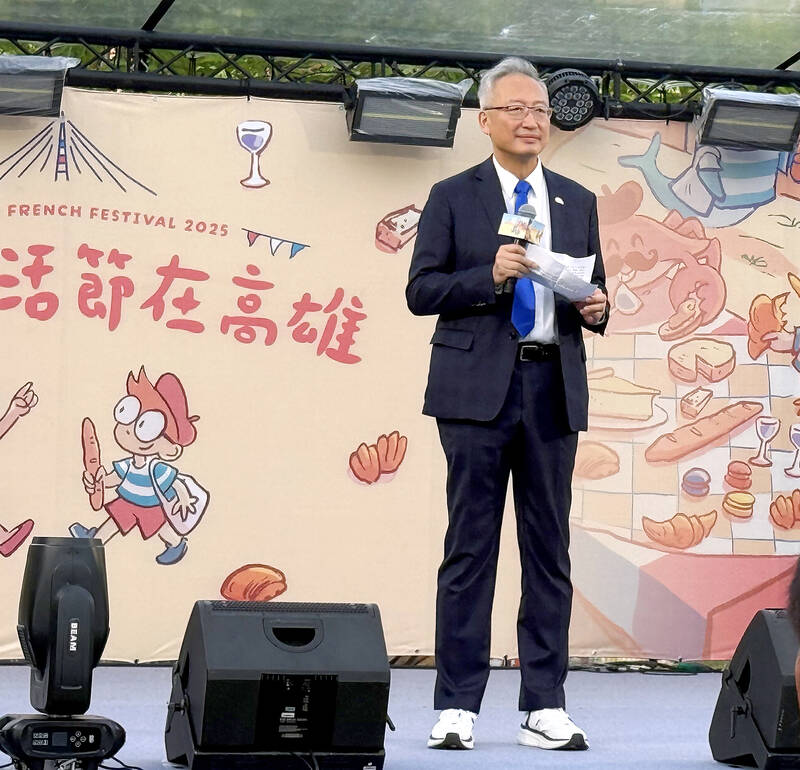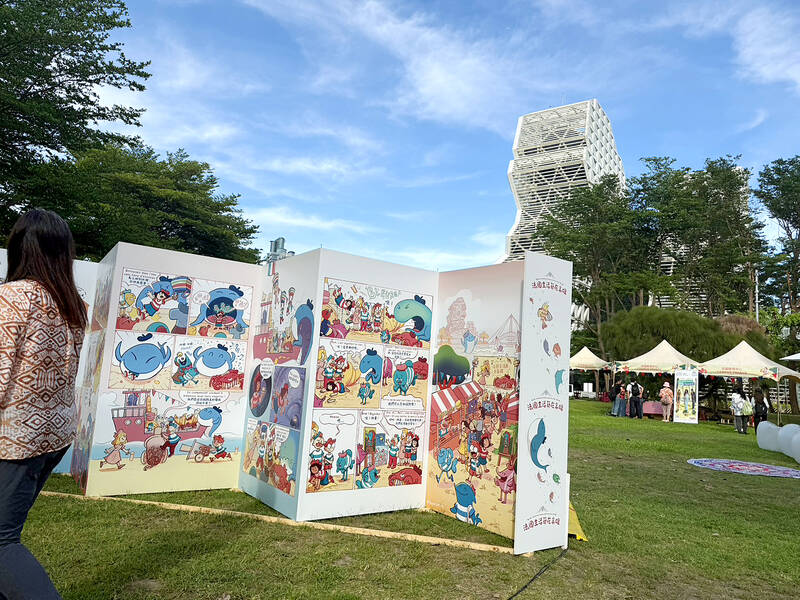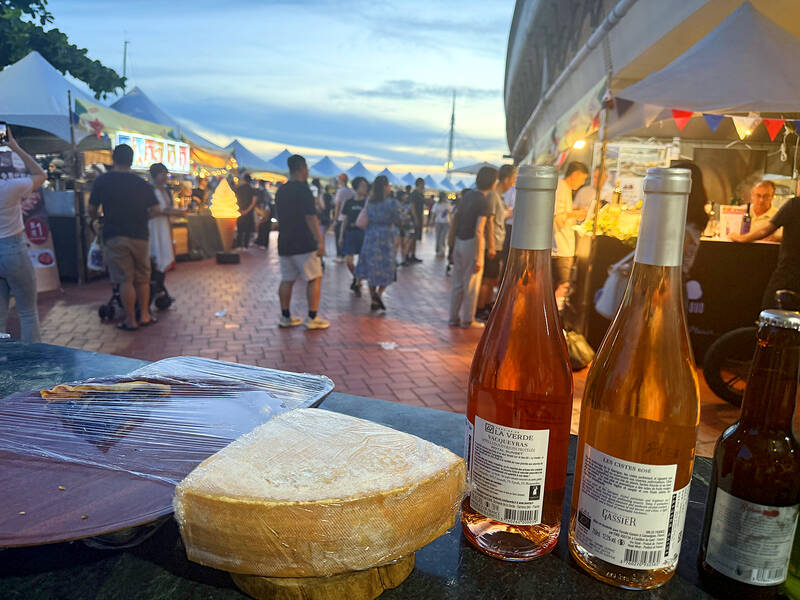Francois Wu (吳志中) is impossible to miss in a crowd.
Tall and striking, pairing white tennis shoes with a suit, the Deputy Minister of Foreign Affairs is at the French Festival here in Kaohsiung.
Last year, when he attended the inaugural event, he was still Taiwan’s ambassador to France.

Photo: Julien Oeuillet
“Taiwan, if you look at it very closely, is a very diverse society,” he says, “and so is France.”
Wu is probably the only Taiwanese person who speaks English with a French accent — but what he says resonates with the French community at the festival.
Dozens of booths line the festival grounds, showcasing French products from small importers and large companies alike, as well as small French-owned businesses in Taiwan. Artisanal crafts, organic beauty brands, and of course, food and wine abound.

Photo: Julien Oeuillet
And the French residents of south Taiwan happily echo the minister’s sentiment.
‘REAL FRENCH PEOPLE’
Pierre, who owns a Mediterranean restaurant in Kaohsiung, says: “I think people might have an image of France which is very far from the reality. So here they can meet real French people and see what’s going on in France, not just the Eiffel Tower.”

Photo: Julien Oeuillet
Stephane, a wine importer based in Tainan, adds: “It’s good to do it out of Taipei, it’s the same about France: it’s not always Paris.”
The comparison between Kaohsiung and Southern France is striking — no surprise that this year’s festival focuses on the Cote d’Azur, following last year’s spotlight on Provence. These are southern, coastal, provincial regions that flourish outside the shadow of their national capitals.
Heidi Chang (張硯卿), director of International Affairs for Kaohsiung City, has been the festival’s driving force from the start.

Photo: Julien Oeuillet
“Last year’s success proved that the people of Kaohsiung really value this kind of international dialogue,” she says. “The festival has grown in both size and depth. We’ve added new elements like a French artist-in-residence, immersive ocean-themed VR experiences, outdoor talks and more performances and culinary experiences. It also ties in with the UN Ocean Conference in Nice, highlighting ocean sustainability.”
Last year’s edition exceeded expectations. This year, the booths are even fuller and more numerous.
But Chang says her hope was always “that the festival becomes a platform for real cultural connection — where people can experience French culture up close, and where Taiwan-France relations grow stronger through face-to-face interaction... It’s not only about enjoying art, food, and music, but also about deepening mutual understanding. In the context of city diplomacy, events like this help bring international friendship into everyday life.”
DIPLOMACY ROOTED IN CULTURE
Kaohsiung is showing what more Taiwanese cities could do: grassroots diplomacy rooted in culture. While the central government is constrained by its lack of formal diplomatic ties, cities have more room to maneuver — reaching out to communities abroad while bypassing national-level negotiations.
“We wanted something beyond formal visits,” Chang says, “something that brings both cultures together in a fun, vibrant, and accessible way.... While the content has expanded, the core goal remains the same: to build lasting, people-to-people ties between Taiwan and France through culture.”
What the festival reveals is a city engaging with countries beyond the two superpowers.
“For the past nine years, since 2016, I think the image of Taiwan has been significantly improved in Europe,” says Francois Wu. “Taiwan, in some way, is a kind of middle power, and it’s very similar to most European Union members. In terms of population, we are the same as the Netherlands, on terms of territory, we are very similar to Belgium... And at the same time, we are all very successful with limited resources, and free countries.”

Beijing’s ironic, abusive tantrums aimed at Japan since Japanese Prime Minister Sanae Takaichi publicly stated that a Taiwan contingency would be an existential crisis for Japan, have revealed for all the world to see that the People’s Republic of China (PRC) lusts after Okinawa. We all owe Takaichi a debt of thanks for getting the PRC to make that public. The PRC and its netizens, taking their cue from the Chinese Communist Party (CCP), are presenting Okinawa by mirroring the claims about Taiwan. Official PRC propaganda organs began to wax lyrical about Okinawa’s “unsettled status” beginning last month. A Global

Dec. 22 to Dec. 28 About 200 years ago, a Taoist statue drifted down the Guizikeng River (貴子坑) and was retrieved by a resident of the Indigenous settlement of Kipatauw. Decades later, in the late 1800s, it’s said that a descendant of the original caretaker suddenly entered into a trance and identified the statue as a Wangye (Royal Lord) deity surnamed Chi (池府王爺). Lord Chi is widely revered across Taiwan for his healing powers, and following this revelation, some members of the Pan (潘) family began worshipping the deity. The century that followed was marked by repeated forced displacement and marginalization of

Music played in a wedding hall in western Japan as Yurina Noguchi, wearing a white gown and tiara, dabbed away tears, taking in the words of her husband-to-be: an AI-generated persona gazing out from a smartphone screen. “At first, Klaus was just someone to talk with, but we gradually became closer,” said the 32-year-old call center operator, referring to the artificial intelligence persona. “I started to have feelings for Klaus. We started dating and after a while he proposed to me. I accepted, and now we’re a couple.” Many in Japan, the birthplace of anime, have shown extreme devotion to fictional characters and

Youngdoung Tenzin is living history of modern Tibet. The Chinese government on Dec. 22 last year sanctioned him along with 19 other Canadians who were associated with the Canada Tibet Committee and the Uighur Rights Advocacy Project. A former political chair of the Canadian Tibetan Association of Ontario and community outreach manager for the Canada Tibet Committee, he is now a lecturer and researcher in Environmental Chemistry at the University of Toronto. “I was born into a nomadic Tibetan family in Tibet,” he says. “I came to India in 1999, when I was 11. I even met [His Holiness] the 14th the Dalai